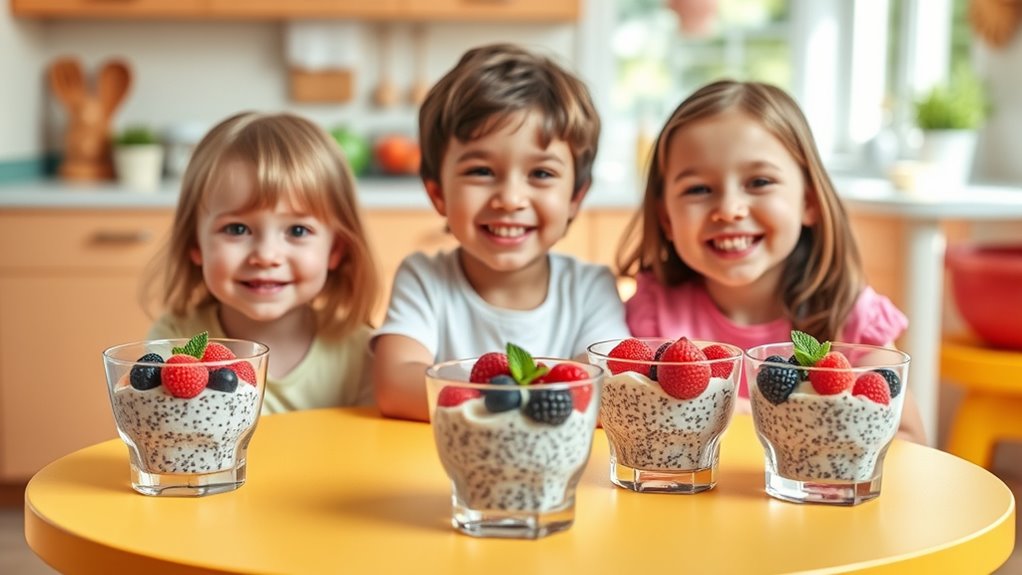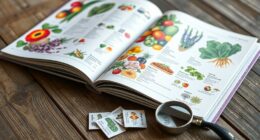To keep your child’s tiny tummy safe, start with just 1 teaspoon of chia seeds per day. Always soak them first to prevent bloating and make them easier to digest. Gradually increase servings as your child gets used to the texture and flavor, but avoid giving too much at once. By introducing chia slowly and in small portions, you help your kid enjoy its health benefits safely—plus, you’ll discover more simple tips for making chia a welcome part of their diet.
Key Takeaways
- Start with 1 teaspoon of soaked chia seeds per serving for young children.
- Gradually increase to 1-2 teaspoons as they tolerate and enjoy.
- Always soak chia seeds before serving to improve digestibility and reduce bloating.
- Ensure children drink plenty of fluids when consuming chia seeds.
- Monitor for any digestive discomfort and adjust serving sizes accordingly.

Chia seeds are becoming a popular snack for kids because they’re nutritious, easy to prepare, and versatile. As a parent, you might wonder if they’re a healthy addition to your child’s diet and how to serve them safely. The truth is, chia seeds pack a punch when it comes to nutritional benefits, making them a smart choice to include in your kid’s meals. They’re loaded with fiber, omega-3 fatty acids, protein, and essential minerals like calcium and magnesium. These nutrients support growing bones, brain development, and overall health. Because they’re so nutrient-dense, even small servings can make a significant difference in your child’s diet.
Chia seeds are a nutritious, versatile snack that supports kids’ growth and health.
However, understanding taste preferences is vital when introducing chia seeds to your kid. Some children are naturally curious about new foods, while others may need a little encouragement. Chia seeds have a mild, nutty flavor that blends well into a variety of foods, making them easy to incorporate without overwhelming your child’s palate. You can add them to smoothies, yogurt, or oatmeal, where they absorb liquids and develop a gel-like texture. This can make the eating experience more appealing and fun. If your child is hesitant, start with small amounts—like a teaspoon—and gradually increase as they become accustomed to the taste and texture.
Serving sizes are especially important because tiny tummies require careful portioning to avoid digestive discomfort. A typical serving size for kids is about one to two teaspoons of chia seeds, which provides ample nutritional benefits without overloading their digestive system. Remember, because chia seeds absorb liquid and swell, it’s best to soak them before serving—either in water, milk, or juice. Soaking not only enhances digestibility but also heightens the taste and texture, making the seeds more palatable for little ones. For example, you can prepare a chia pudding the night before, letting the seeds swell overnight, and then serve it with fresh fruit on top. This way, your child gets a nutritious treat that’s easy to eat and gentle on their stomach. Incorporating adequate hydration when serving chia seeds is essential to prevent any potential digestive issues.
Always keep in mind that moderation is key. While chia seeds are a superfood, overdoing it can lead to bloating or discomfort. Incorporate them gradually into your child’s diet, observing how they respond, and adjusting serving sizes accordingly. With a little creativity and attention to taste preferences, you can help your child enjoy the nutritional benefits of chia seeds safely and deliciously.
Frequently Asked Questions
Are Chia Seeds Suitable for Children With Nut Allergies?
If you’re wondering about nut allergy concerns, chia seeds are generally safe for children with nut allergies, as they aren’t nuts. However, always check for cross-contamination and consult with your child’s doctor before introducing new foods. If there’s any doubt, consider seed alternatives like sunflower or pumpkin seeds. These options can provide similar benefits without risking allergic reactions, giving you peace of mind while expanding your child’s diet.
How Do I Prevent Chia Seeds From Clumping in Children’s Snacks?
Imagine a scene straight out of a 90s sitcom—your snacks turning into a mess! To prevent chia seeds from clumping, stir them thoroughly into liquids, then let them sit for a few minutes before serving. This helps achieve a smooth, consistent texture and avoids seed clumping. You can also mix chia seeds into wet ingredients last, ensuring snack consistency stays appealing and kid-friendly.
Can Kids Eat Chia Seeds Every Day Safely?
You might wonder if kids can eat chia seeds daily. Generally, chia seed benefits include fiber, omega-3s, and antioxidants, making them a healthy addition. However, you should be aware of chia seed risks like choking or digestive issues if consumed in large amounts. Small, controlled servings—like a teaspoon daily—are safe, but it’s best to introduce them gradually and guarantee kids drink plenty of water.
What Are Creative Ways to Serve Chia Seeds to Kids?
Imagine chia seeds as tiny treasures waiting to be discovered. To make serving them fun, combine them with fun flavor combinations like fruit smoothies or yogurt parfaits. Use a colorful presentation by adding vibrant berries or sprinkles. You could also create chia pudding layered with bright fruits or make fun-shaped snacks. These creative ideas turn healthy chia into exciting treats, delighting kids and encouraging them to enjoy nutritious eating every day.
How Do Chia Seeds Impact Children’s Digestion?
Chia seeds impact your child’s digestion by providing fiber benefits that promote healthy bowel movements. When kids consume chia, it absorbs water and forms a gel, which helps smooth digestion and prevents constipation. You’ll notice improved digestive health as the fiber supports gut function. Just remember to serve appropriate portions, as too much can cause bloating or discomfort. Incorporating chia seeds gradually guarantees they enjoy the benefits without any tummy troubles.
Conclusion
Now that you know the safe serving sizes, imagine introducing chia to your little one’s diet—what new textures and flavors might they discover? Will they love the chewy bites or be surprised by the pudding’s creaminess? Just remember, a little goes a long way, and watching their reactions will make every spoonful exciting. Stay mindful, stay curious, and keep exploring—who knows what healthy surprises are waiting just around the corner?
















